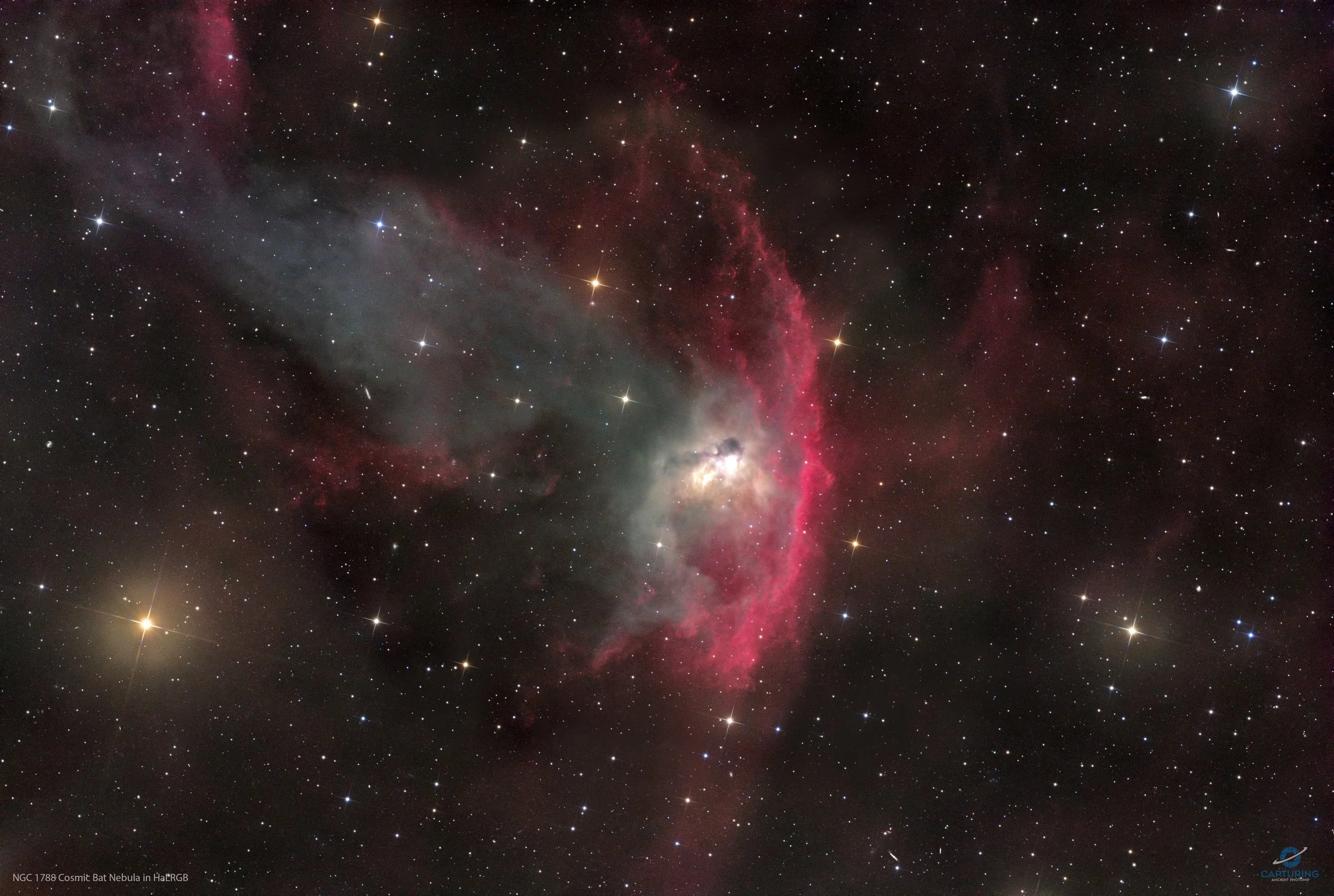
AAPOD2 Image Archives
SH2-308 Dolphin Head Nebula
The Dolphin's Head Nebula (Sh2-308) is an emission nebula located in the constellation Canis Major, approximately 4,500 light-years away. This bubble-shaped nebula is created by the strong stellar winds from the Wolf-Rayet star EZ Canis Majoris (WR 6), a massive, dying star in the final stages of its life.
The nebula spans about 60 light-years across, with its faint glow originating from ionized hydrogen gas illuminated by the ultraviolet radiation of the central star. Sh2-308 is an example of a Wolf-Rayet bubble, a structure formed when stellar winds sweep up the surrounding material. It is a fleeting structure in astronomical terms, lasting only a few hundred thousand years before dissipating into space.
NGC 1788 Cosmic Bat Nebula in HaLRGB
Nestled in a dark corner of the constellation Orion, NGC 1788, often called the Cosmic Bat Nebula, is a mysterious reflection nebula shaped by the intricate interplay of light and shadow. This dark yet luminous region spans around 2,000 light-years away and is illuminated by a cluster of young, hot stars hidden within its veils of gas and dust. The nebula’s distinct wingspan-like shape gives it a resemblance to a bat in flight, shrouded in cosmic dust that filters and scatters light, creating its haunting glow.
What sets NGC 1788 apart is its relative isolation from other bright stellar nurseries in Orion, making it a more enigmatic region of star formation. The surrounding dark nebulae contribute to its dramatic appearance, providing a stark contrast to the glowing reflection.
Captured from Perth, Western Australia, under some of the clearest skies in the Southern Hemisphere, this HaLRGB composite image combines hydrogen-alpha data to accentuate fine details with RGB color channels to provide a naturalistic palette. The city’s unique geographic location, far from light pollution, allows for a pristine view of deep-sky treasures like NGC 1788, showcasing its delicate interplay of gas, dust, and starlight.
A cosmic enigma wrapped in shadows and light, the Cosmic Bat Nebula is a testament to the beauty of hidden stellar processes unfolding in the quiet reaches of the universe.
NGC 2736 Pencil Nebula in HOO
NGC 2736, also recognized as the Pencil Nebula. Situated in the Vela constellation, this elongated nebula is a remnant of a supernova explosion, showcasing intricate tendrils of ionized hydrogen and oxygen gases.
The hydrogen alpha emissions, depicted in red, highlight regions of intense star formation and energetic interactions. The oxygen emissions, represented in greenish-blue, offer insights into the nebula's chemical composition and the aftermath of the supernova explosion.
The Pencil Nebula is part of the larger Vela Supernova Remnant, an expansive shell of gas and dust resulting from the cataclysmic death of a massive star. This supernova event likely occurred thousands of years ago, and the Pencil Nebula serves as a testament to the transformative forces unleashed in such stellar explosions.
The delicate structure of the Pencil Nebula is sculpted by the shockwaves generated during the supernova explosion. These shockwaves compress and heat the surrounding interstellar material, giving rise to the nebula's intricate filaments and wisps.
The Lagoon and Trifid Nebula in Foraxx/HSO
This image captures the stunning beauty of the Lagoon Nebula (M8) and the Trifid Nebula (M20) in the narrowband color palette of Foraxx/HSO (Hydrogen-Alpha, Sulfur, and Oxygen). Situated in the constellation Sagittarius, these celestial wonders showcase their intricate structures and vivid colors in this composite view.
The Lagoon Nebula, resembling a celestial lagoon surrounded by dark lanes of interstellar dust, is a region of intense star formation. In contrast, the Trifid Nebula exhibits its distinctive three-lobed appearance, with blue reflection nebulae, dark lanes, and pink emission regions. The Foraxx/HSO color scheme emphasizes the unique emissions of hydrogen, sulfur, and oxygen, revealing the dynamic interplay of gas and dust within these nebulous regions. This image is not only a visual feast but also a scientific treasure trove, offering valuable insights into the birth and evolution of stars in our galaxy.
M20 Trifid Nebula in HaRGB
The Trifid Nebula, a celestial masterpiece captured in the vast expanse of our galactic tapestry. Situated approximately 5,200 light-years away in the constellation Sagittarius, this mesmerizing nebula combines interstellar gas, dust, and the dazzling radiance of newborn stars to create a captivating visual symphony. Its name derives from the intricate filaments that divide the nebula into three distinct sections.
As new stars ignite within its vast expanse, the Trifid Nebula unveils the ongoing spectacle of stellar birth and evolution, captivating our imaginations and offering a glimpse into the captivating beauty of our ever-expanding universe.






